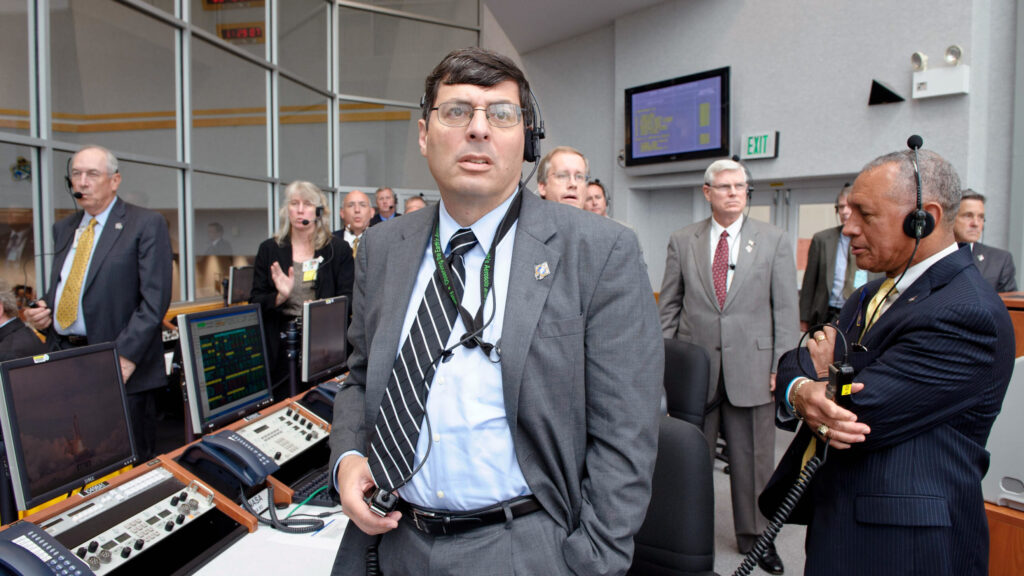
In this handout provided by the National Aeronautics and Space Administration (NASA), NASA Administrator Charles Bolden, right, Associate Administrator Christopher Scolese, left, and other management look on from Firing Room Four of the Launch Control Center (LCC) as space shuttle Atlantis launches from pad 39A at Kennedy Space Center July 8, 2011 in Cape Canaveral, Florida.(Photo by Bill Ingalls/NASA via Getty Images)
WASHINGTON: The National Reconnaissance Agency and Space Command are still working out “strategies” for coordinating operations under the “protect and defend” strategic framework they signed last year — including when NRO may need to take direction from SPACECOM during conflict or an impending attack, according to the spy agency’s director.
The framework agreement, Chris Scolese told the Mitchell Institute today, establishes “how we’re going to operate under various conditions, because it will be necessary for us to coordinate, and in some instances take direction. And we have agreed to do that.”
The two sides are now “developing the strategies, and how that happens. And when it happens, and under what situations it happens,” he added. “But the most important part of it is the formalization of the tight structure that we have to understand what’s going on in space, so that we operate in a consistent manner at all times.”
The landmark framework stemmed from a 2019 decision to create a “unified” concept of operations for national security satellites that gave SPACECOM the power to tell NRO to move its satellites when the combatant command is convinced the nation’s spy satellites are in harm’s way.
Under the Unified Command Plan, SPACECOM is responsible for both providing satellite capabilities to the Joint Force during conflict, and protecting and defending those capabilities.
Scolese stressed, however, that NRO remains both a creature of the Intelligence Community (with reporting responsibilities to the Director of National Intelligence Avril Haines) as well as the Defense Department.
“We have to remember, though, that the NRO sits both in the IC and the DoD, and we have to address all of those sets of requirements,” he said. “So, for the most part, it’s a coordination effort, but sometimes it will be: ‘Hey, you need to do this, and we will do that’.”
As for where the NRO “points” its various intelligence, reconnaissance and surveillance (ISR) satellites during a conflict, that also remains a work in progress as part of the agreement with SPACECOM, Scolese said.
The complicated and sometimes controversial question of who gets priority access to ISR data during conflict long has been a thorn in the side of US military commanders, who complain that their real-time battlefield needs consistently take a back seat to the intel demands of the president and other senior US government leaders.
“NRO gets its direction from what to look at and listen to, from our functional managers, which are the National Security Agency and the National Geospatial intelligence Agency,” Scolese explained. “They collect all the requirements from the combatant commands from the broader DoD and from the intelligence community, and then let us know where the priorities are. And then we go off and manage the constellation to deliver what’s needed.”
He stressed that SPACECOM plays a role in the process, and that what their requirements are will need to be taken into account when satellite tasking decisions are made.
“[T]hat has to play a factor into into what we do, and how we schedule our systems. So we’re working out how do we balance all of those different different activities,” he said.
Scolese noted that DoD efforts to build a “proliferated architecture” that is more resilient —that is, building more satellites in more orbits, as well as figuring out how to integrate commercial capabilities — also will help address the seemingly endless military demand for space-based ISR.
As for how NRO and Space Force split up efforts to acquire ISR satellites, whether their own or from commercial firms, he said the ongoing Space Force study, with NRO participation, of space-based ISR requirements would guide those decisions about coordination. This includes sorting out responsibilities for acquiring ground moving target indicators both between NRO and Space Force, and between the Space Force and the Air Force.
“We recognize that we have to work together in order to develop that capability at scale that we’re going to need as we work in more denied areas,” he stressed.
Scolese further noted that NRO and Space Force already have some “co-funded” joint projects, explaining that he and Air Force Secretary Frank Kendall, who oversees both the Space Force and Air Force, are working to “tighten that relationship.
We’re going to work more closely together, and we’re going to find ways so that we can be efficient from a government standpoint,” Scolese said.
Air Force picks Anduril, General Atomics for next round of CCA work
The two vendors emerged successful from an original pool of five and are expected to carry their drone designs through a prototyping phase that will build and test aircraft.


























